AUDI RS7 SPORTBACK 2016 Owners Manual
Manufacturer: AUDI, Model Year: 2016, Model line: RS7 SPORTBACK, Model: AUDI RS7 SPORTBACK 2016Pages: 282, PDF Size: 70.78 MB
Page 141 of 282
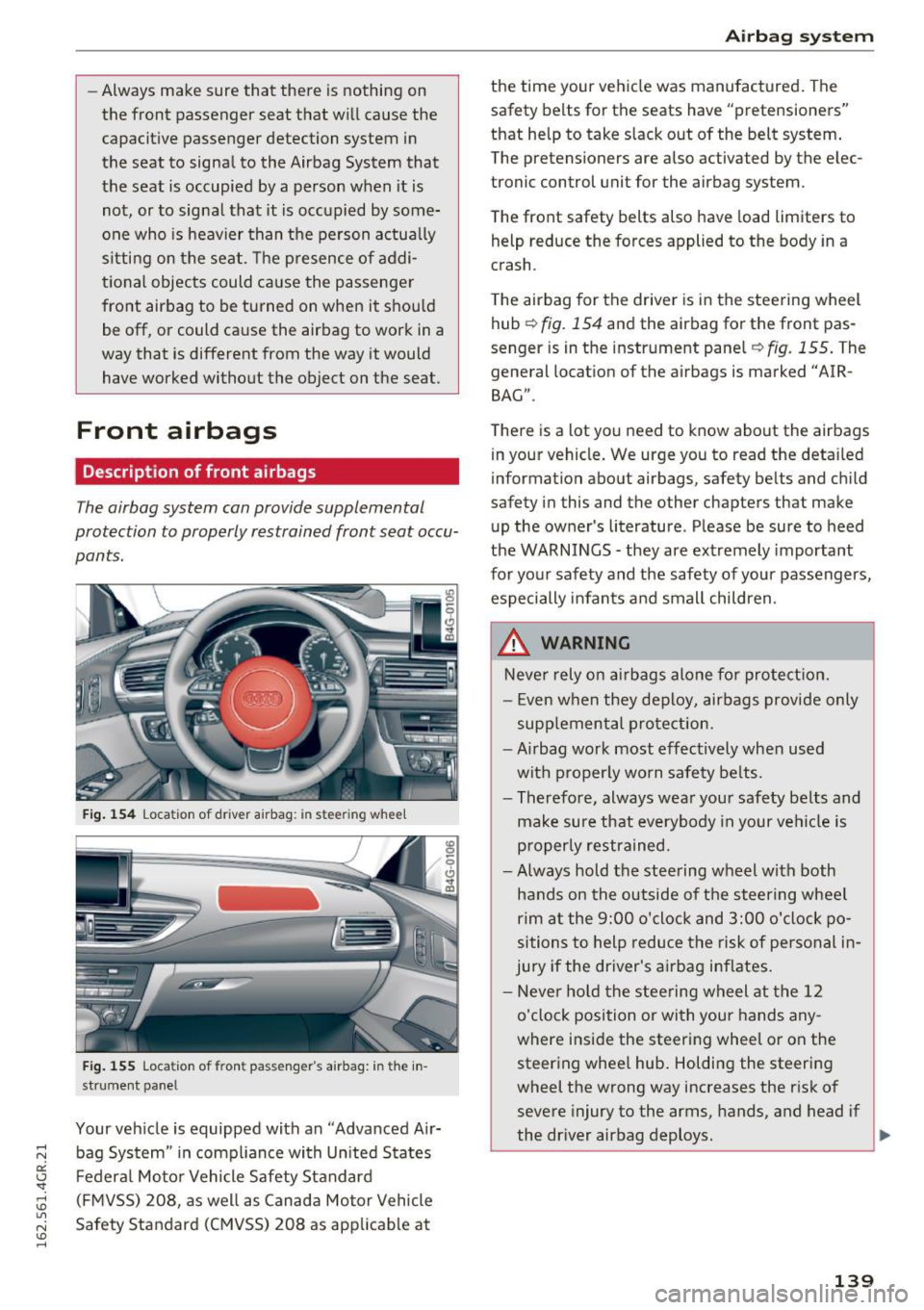
-Always make sure that there is nothing on
the front passenger seat that will ca use the
capacit ive passenger detection system in
the seat to signal to the Airbag System that
the seat is occupied by a person when it is
not, or to signa l that it is occupied by some
one who is heavier than the person actua lly
sitting on the seat. The p resence of addi
tional objects could cause the passenger
front airbag to be turned on when it shou ld
be off, or could cause the airbag to work in a
way that is different from the way it would
have worked without the object on the seat.
Front airbags
Description of front airbags
The airbag system con provide supplemental
protection to properly restrained front seat occu
pants.
F ig. 154 Location of driver airbag: in steering whee l
Fig. 155 Location of front passenger 's airbag: in th e in
strume nt panel
Your veh icle is equipped with an "Advanced Air
bag System" in comp liance with United States
F edera l Moto r Vehicle Safety Standard
( FM VSS) 208, as well as Canad a Moto r Vehicle
Safety Standard (CMVSS) 208 as app licab le at
Airb ag sys tem
the time your ve hicle was manufactured . The
safety belts for the seats have "pretensioners"
that help to take slack out of the belt system .
The pretensioners are also activated by the elec
tronic control unit for the airbag system.
The front safety belts also have load limiters to
help reduce the forces applied to the body in a
crash.
T he airbag for the drive r is in the steering wheel
hub ~
fig. 154 and the airbag for the front pas
senger is in the instrument panel~
fig. 155 . The
general locat ion of the airbags is marked "AIR
BAG".
There is a lot you need to know about the airbags i n your vehicle . We urge you to read the deta iled
information about airbags, safety be lts and ch ild
safety in this and the other chapters that make
up the ow ner's literature . Please be sure to heed
the WARNINGS - they are extremely important
for yo ur safety and the safety of your passengers,
especially infan ts and small children.
_&. WARNING
-
Neve r rely o n ai rbags alone fo r prote ct ion.
- E ven w hen they deploy, airbags provide only
supp lemental pro tection.
- Ai rbag work most effectively when used
with p roperly worn safety belts.
- Therefo re, always wear your safety belts and
make sure that everybody in your ve hicle is
p roperly restrained.
- Always hold the steering w heel with both
ha nds on the outside of the steering wheel
rim at the 9:00 o'clock and 3 :00 o'clock po
sitions to help reduce t he risk of personal i n
jury if the driver's a irbag inflates.
- Never hold the stee ring wheel at the 12
o'clock position or wi th your hands any
where inside the steering wheel o r on the
steer ing whee l hub . Holding the steering
wheel the wrong way increases the r isk of
severe injury to the arms, hands, and head if
the dr iver airbag deploys.
~
139
Page 142 of 282
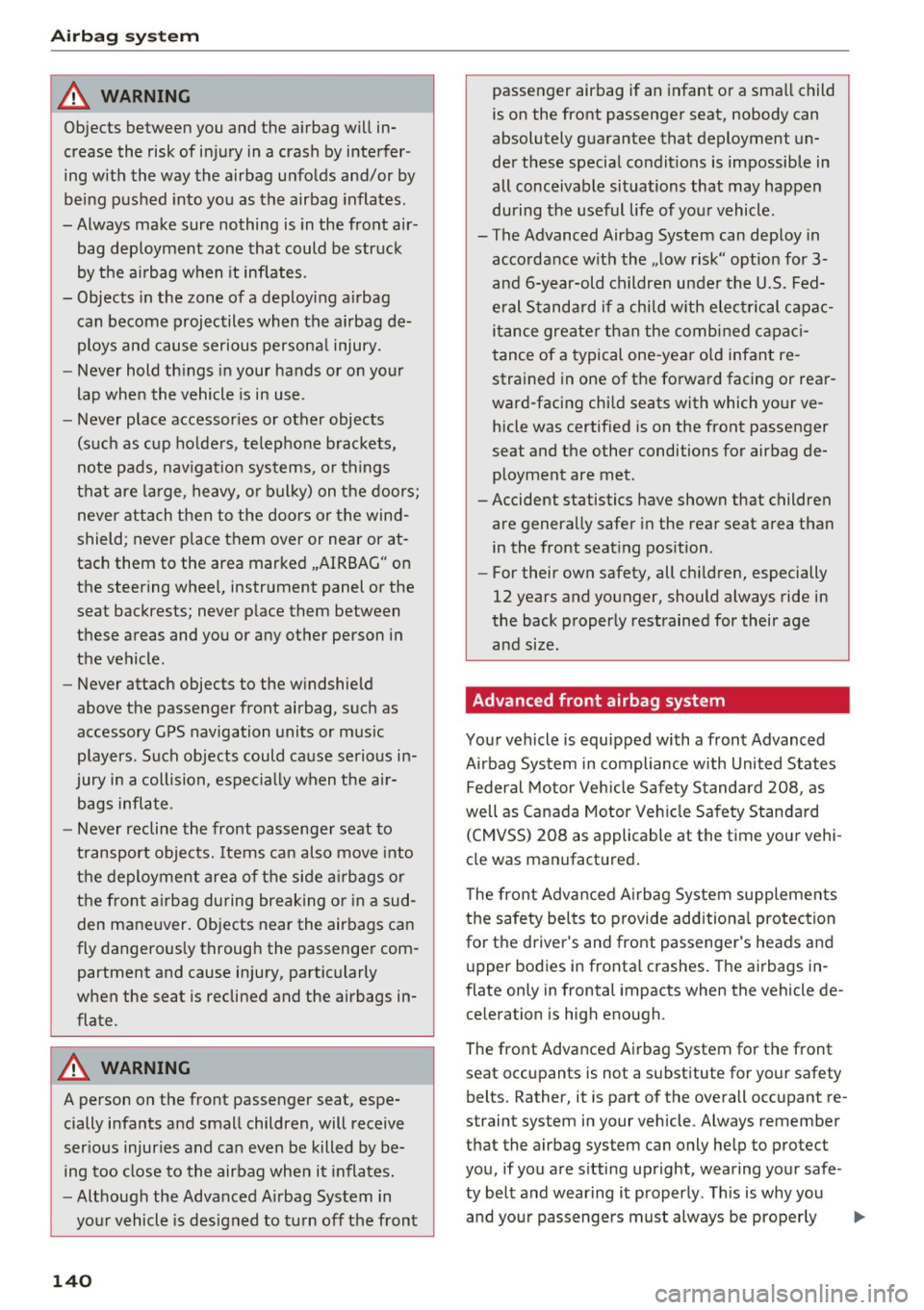
Airbag system
& WARNING
Objects between you and the airbag will in
crease the risk of injury in a crash by interfer
ing with the way the airbag unfolds and/or by
being pushed into you as the airbag inflates.
-Always make sure nothing is in the front air -
bag deployment zone that could be struck
by the airbag when it inflates .
- Objects in the zone of a deploying airbag
can become projectiles when the airbag de
ploys and cause serious personal injury.
- Never hold things in your hands or on your
lap when the vehicle is in use .
- Never place accessories or other objects
(such as cup holders, telephone brackets,
note pads, navigation systems, or things
that are large, heavy, or bulky) on the doors;
never attach then to the doors or the wind
shield; never place them over or near or at
tach them to the area marked ,,AIRBAG" on
the steering wheel, instrument panel or the
seat backrests; never place them between
these areas and you or any other person in
the vehicle.
- Never attach objects to the windshield
above the passenger front airbag, such as
accessory GPS navigation units or music
players . Such objects could cause serious in
jury in a collision , especially when the air
bags inflate .
- Never recline the front passenger seat to
transport objects. Items can also move into
the deployment area of the side airbags or
the front airbag during breaking or in a sud
den maneuver. Objects near the airbags can
fly dangerously through the passenger com
partment and cause injury, particularly
when the seat is reclined and the airbags in
flate.
& WARNING
A person on the front passenger seat, espe cially infants and small children, will receive
serious injuries and can even be killed by be
ing too close to the airbag when it inflates.
-Although the Advanced Airbag System in
your vehicle is designed to turn off the front
140
-
passenger airbag if an infant or a small child
is on the front passenger seat, nobody can
absolutely guarantee that deployment un
der these special conditions is impossible in
all conceivable situations that may happen
during the useful life of your vehicle .
- The Advanced Airbag System can deploy in
accordance with the ,,low risk" option for 3-
and 6-year-old children under the U .S . Fed
eral Standard if a child with electrical capac
itance greater than the combined capaci
tance of a typical one-year old infant re
strained in one of the forward facing or rear
ward-facing child seats with which your ve
hicle was certified is on the front passenger
seat and the other conditions for airbag deployment are met .
- Accident statistics have shown that children
are generally safer in the rear seat area than
in the front seating position .
- For their own safety, all children, especially
12 years and younger, should always ride in
the back properly restrained for their age
and size.
Advanced front airbag system
Your vehicle is equipped with a front Advanced
Airbag System in compliance with United States
Federal Motor Vehicle Safety Standard 208, as
well as Canada Motor Vehicle Safety Standard
(CMVSS) 208 as applicable at the time your vehi
cle was manufactured.
The front Advanced Airbag System supplements
the safety belts to provide additional protection
for the driver's and front passenger's heads and upper bodies in frontal crashes. The airbags in
flate only in frontal impacts when the vehicle de
celeration is high enough.
The front Advanced Airbag System for the front
seat occupants is not a substitute for your safety belts. Rathe r, it is part of the overall occupant re
straint system in your vehicle . Always remember
that the airbag system can only help to protect
you, if you are sitting upright, wearing your safe
ty belt and wearing it properly . This is why you
and your passengers must always be properly .,.
Page 143 of 282
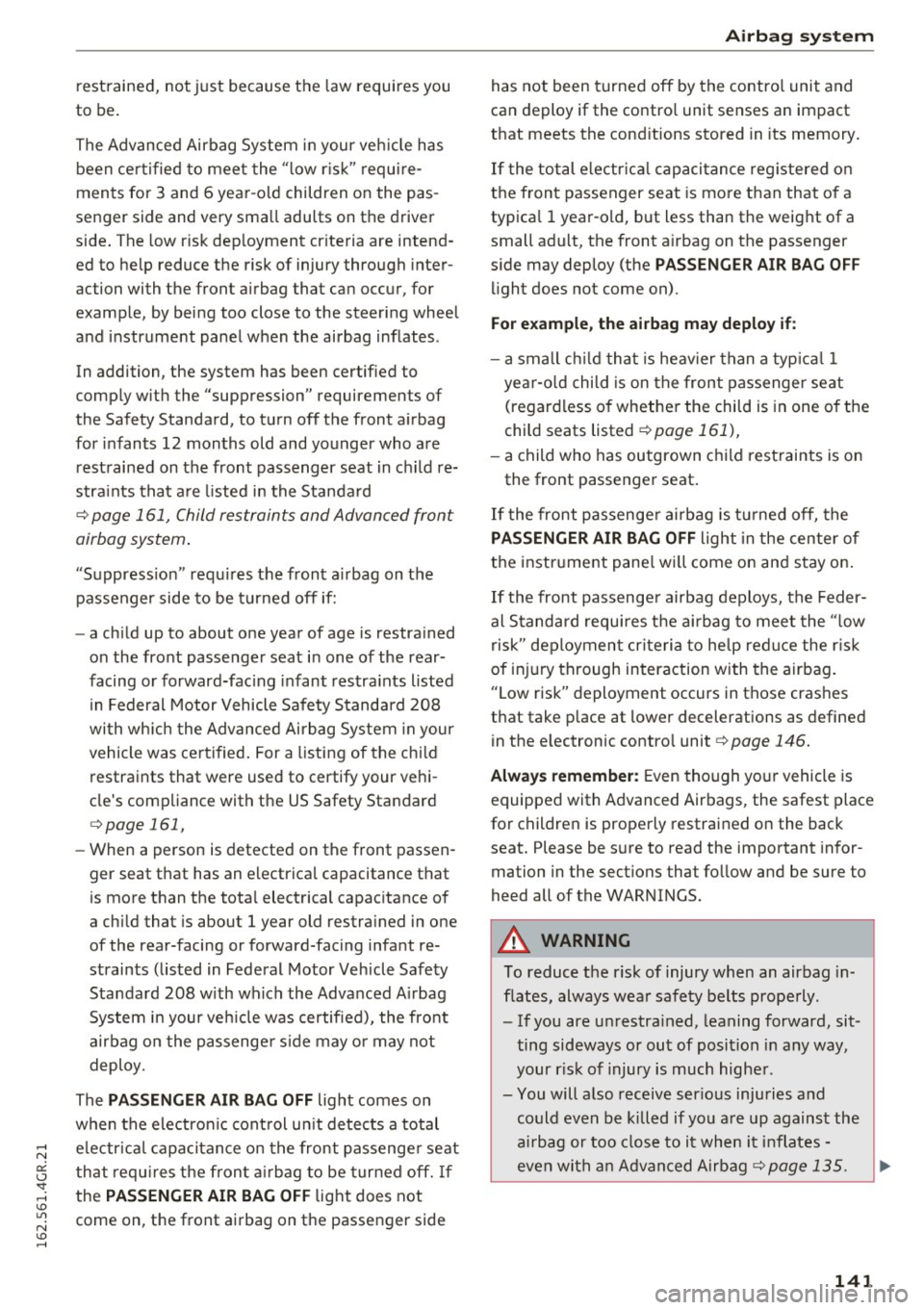
restrained, not just because the law requires you
to be.
The Advanced Airbag System in your ve hicle has
been certified to meet the " low r isk" require
ments for 3 and 6 yea r-o ld children on the pas
senger side and very sma ll adults on the driver
side . The low r isk dep loyment cr iteria are intend
ed to help reduce the risk of injury through inter
action with the front a irbag that can occur, for
examp le, by being too close to the steering wheel
and instrument panel when the airbag inflates .
In addition, the system has been certified to
comply w ith the "suppression" requirements of
the Safety Standard, to turn off the front a irbag
for infants 12 months old and younger who are
restrained on the front passenger seat in child re
stra ints that a re listed in the Standard
¢ page 161, Child restraints and Advanced front
airbag system .
"Suppression" requ ires the front a irbag on the
passenger side to be turned off if:
- a ch ild up to about one year of age is restra ined
on the fro nt passenger seat i n one of the rear
facing or forward-fac ing infant restra ints listed
in Federal Motor Vehicle Safety Standard 208
with wh ich the Advanced Airbag System in your
vehicle was certified . For a listing of the ch ild
restraints that were used to certify your vehi
cle's compliance with the US Safety Standard
¢ page 161,
-When a person is detected on the front passen
ger seat that has an electrical capacitance that
is more than the tota l electrical capac itance of
a ch ild that is about 1 year old restra ined in one
of the rear-facing or forward-facing infant re
straints (listed in Federal Motor Veh icle Safety
Standard 208 w ith which the Advanced A irbag
System i n your veh icle was certified), the front
airbag o n the passenge r side may o r may not
deploy.
The
P A SSENGER AIR B AG OFF light comes on
when the electron ic cont rol un it detects a total
e lectrical capacitan ce on the front passenge r seat
that requ ires the front a irbag to be turned off. If
the
PAS SENGER AIR BAG OFF light does not
come on, the front airbag on the passenger side
Airb ag sys tem
has not been turned off by the contro l unit and
can deploy if the contro l unit senses an impact
that meets the cond itions stored in its memory.
If the total e lectr ica l capaci tance reg istered on
the front passenger seat is mo re than that of a
typica l 1 year -old, but less than the weight of a
small adult, the front a irbag on the passenger
s ide may deploy (the
PA SS ENGER AIR BA G OFF
light does not come on).
For example , the ai rbag ma y deplo y if:
- a small ch ild that is heav ier than a typ ica l 1
yea r-o ld child is on the front passenger seat
(regardless o f whether the child is in one of the
child seats listed
¢ page 161),
-a child who has outgrown c hild restraints is on
the front passenge r seat .
If the front passenge r a irbag is t urned off, the
PASSENGER AIR BAG OFF light in the center of
the instrument pane l wi ll come on and stay on .
If the front passenger a ir bag deploys, the Feder
al Standa rd requi res the ai rbag to meet the "low
risk" deployment criteri a to he lp redu ce the r isk
of inj ury th rough interaction with the airbag .
" Low risk" deployment occurs in those crashes
that take p lace at lower decelerations as defined
in the electronic contro l unit ¢
page 146.
Alwa ys remember : Even though your vehicle is
equipped with Advanced Airbags, the safest place
for children is properly restrained on the back
seat. Please be sure to read the important infor
mation in the sections that fo llow and be sure to
heed all of the WARNINGS.
A WARNING
To reduce the risk of injury when an airbag in
flates, always wea r safety belts properly.
- If you are u nrestra ined, leaning forward, sit
ting sideways or out of position in any way,
your r is k of injury is much highe r.
- You will also receive ser ious injuries and
could even be killed if yo u are up against the
ai rbag or too close to it when it inflates -
even with an A dvanced Airbag
¢page 135.
141
Page 144 of 282
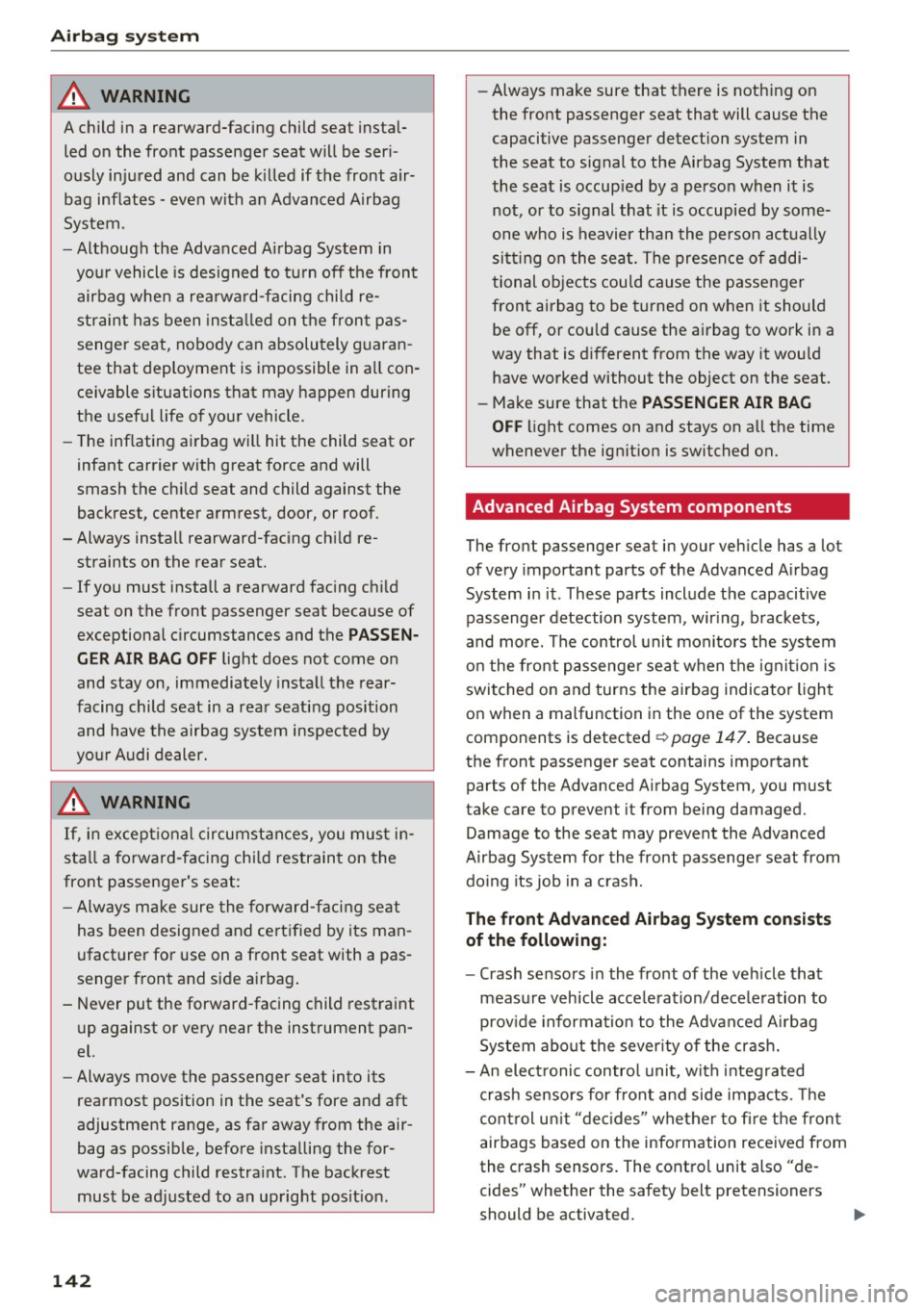
Airbag syste m
A WARNING
A child in a rearward-facing chi ld seat instal
led on the front passenger seat will be ser i
ously injured and can be k illed if the front air
bag inflates - even with an Advanced Airbag
System.
- Although the Advanced A irbag System in
you r vehicle is designed to tu rn off the front
airbag when a rea rward-facing child re
straint has been insta lled on the fron t pas
senger seat, nobody can absolutely g uaran
tee that deployment is impossible in a ll con
ceivable situations that may happen during
the useful life of your vehicle.
- The inflating airbag w ill hit the child seat or
infant carrier w ith great force and will
smash the ch ild seat and child against the
backrest, center armrest, door, or roof.
- Always install rearward-facing ch ild re
straints on the rear seat.
- If you must install a rearward fac ing ch ild
seat on the front passenger seat because of
exceptional c ircumstances and the
PASSEN
G ER A IR BAG OFF light does not come on
and stay on, immediately insta ll the rear
facing child seat in a rea r seating pos ition
and have the airbag system inspected by
yo ur Audi dealer.
A WARNING
If, i n ex cept ional circumstances, you must i n
stall a forward-facing chi ld restraint on the
front passenger's seat:
- Always make sure the forward-facing se at
has been designed and ce rtified by its man
ufacturer for use on a f ront seat with a pas
senger front and side a irbag .
- Never put the forward -facing child restraint
u p against or very near the instrument pan
el.
- Always move the passenger seat into its
rearmost position in the seat's fore and aft
adjustment range, as fa r away from the air
bag as possib le, before insta lling the for
ward-facing child restra int. The backrest
must be adjusted to an upright posit ion.
142
- Always make sure that there is noth ing on
the front passenge r seat that will cause the
capacitive passenger detection system in
the seat to signal to the Airbag System that
the seat is occup ied by a person when it is
not, or to s ignal that it is occupied by some
one who is heavier than the person act ually
si tti ng o n the sea t. T he prese nce of addi
tional obje cts could cause the passenger
front airbag to be turned on when it should
be off , or could cause the airbag to work in a
way that is d ifferent from the way it wou ld
have wo rked without the object on the seat.
- Make sure that the
PASSENGER AIR BAG
OF F light comes on and stays on all the time
whenever the ignit ion is switched on.
Advanced Airbag System components
The front passenger seat in your veh icle has a lot
of ve ry important parts of the Advanced A irbag
System i n it. These parts incl ude t he capacitive
passenger detection system, wir ing, b rackets,
and more. The control uni t monitors the system
o n the front passenge r seat when t he ignit ion is
swi tched on and turns the airbag indica tor ligh t
o n when a malfunction in the one of the system
components is detected
~ page 147 . Because
the front passenger seat contains important
parts of the Advanced Airbag System, you must
take care to prevent it from being damaged.
Damage to the seat may prevent the Advanced
Airbag System for the front passenger seat from
do ing its job in a crash.
The front Advanced Airbag System consists
of the following:
- Crash sensors i n the front of the veh icle that
measu re vehicle acce le ration/dece le ration to
prov ide informa tion to the Advanced A irbag
System abo ut the sever ity of the cr as h .
- An elect roni c contro l unit, w ith integ rated
cr ash sensors for front an d side impacts. The
c ont rol u nit "de cides" whether to fi re the fron t
airbags based on the information received from
the crash sensors. The cont ro l unit also "de
cides" whether the safety belt pretensioners
should be activated. ..,_
Page 145 of 282
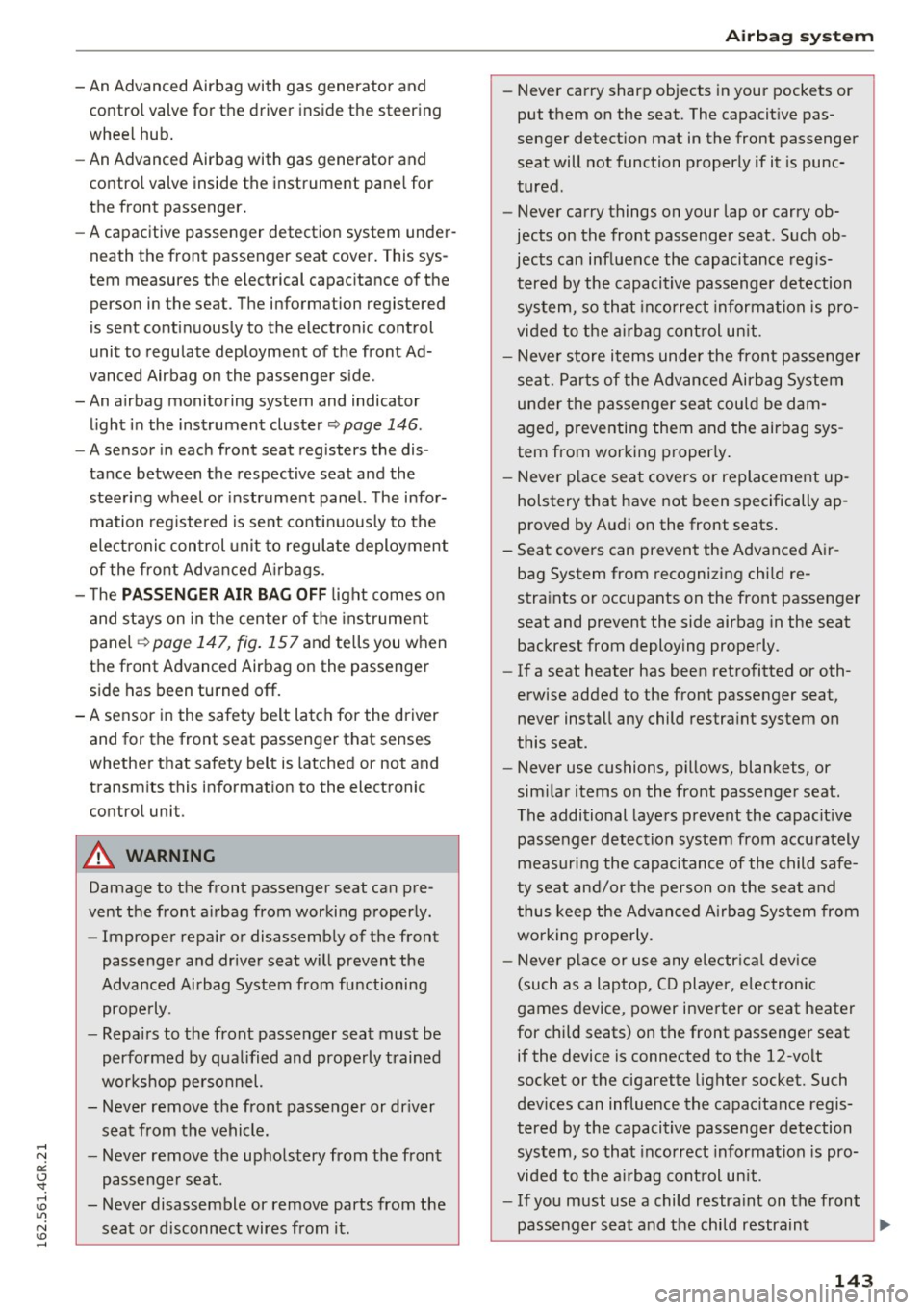
-An Advanced Airbag with gas generator and
control valve for the driver inside the steering
wheel hub.
- An Advanced Airbag with gas generator and
control valve inside the instrument panel for
the front passenger.
- A capacitive passenger detection system under
neath the front passenger seat cover. This sys
tem measures the electrical capacitance of the
person in the seat. The information registered
is sent continuously to the electronic control
unit to regulate deployment of the front Ad
vanced Airbag on the passenger side .
- An airbag monitoring system and indicator
light in the instrument cluster
~ page 146.
-A sensor in each front seat registers the dis
tance between the respective seat and the
steering wheel or instrument panel. The infor
mation registered is sent continuously to the
electronic control unit to regulate deployment
of the front Advanced Airbags.
- The
PASSENGER AIR BAG OFF light comes on
and stays on in the center of the instrument
panel ~
page 147, fig. 157 and tells you when
the front Advanced Airbag on the passenger side has been turned off.
- A sensor in the safety belt latch for the driver
and for the front seat passenger that senses
whether that safety belt is latched or not and
transmits this information to the electronic control unit.
A WARNING
Damage to the front passenger seat can pre
vent the front airbag from working properly.
- Improper repair or disassembly of the front
passenger and driver seat will prevent the
Advanced Airbag System from functioning properly.
- Repairs to the front passenger seat must be
performed by qualified and properly trained
workshop personnel.
- Never remove the front passenger or driver
seat from the vehicle.
- Never remove the upholstery from the front
passenger seat.
- Never disassemble or remove parts from the
seat or disconnect wires from it.
Airbag system
-Never carry sharp objects in your pockets or
put them on the seat. The capacitive pas
senger detection mat in the front passenger
seat will not function properly if it is punc
tured.
- Never carry things on your lap or carry ob
jects on the front passenger seat. Such ob
jects can influence the capacitance regis
tered by the capacitive passenger detection
system, so that incorrect information is pro
vided to the airbag control unit.
- Never store items under the front passenger
seat. Parts of the Advanced Airbag System
under the passenger seat could be dam
aged, preventing them and the airbag sys
tem from working properly.
- Never place seat covers or replacement up
holstery that have not been specifically ap
proved by Audi on the front seats.
- Seat covers can prevent the Advanced Air
bag System from recognizing child re
straints or occupants on the front passenger
seat and prevent the side airbag in the seat
backrest from deploying properly.
- If a seat heater has been retrofitted or oth
erwise added to the front passenger seat,
never install any child restraint system on
this seat.
- Never use cushions, pillows, blankets, or
similar items on the front passenger seat.
The additional layers prevent the capacitive
passenger detection system from accurately
measuring the capacitance of the child safe
ty seat and/or the person on the seat and
thus keep the Advanced Airbag System from
working properly.
- Never place or use any electrical device
(such as a laptop, CD player, electronic
games device, power inverter or seat heater
for child seats) on the front passenger seat if the device is connected to the 12-volt
socket or the cigarette lighter socket. Such
devices can influence the capacitance regis
tered by the capacitive passenger detection
system, so that incorrect information is pro
vided to the airbag control unit.
- If you must use a child restraint on the front
passenger seat and the child restraint
~
143
Page 146 of 282
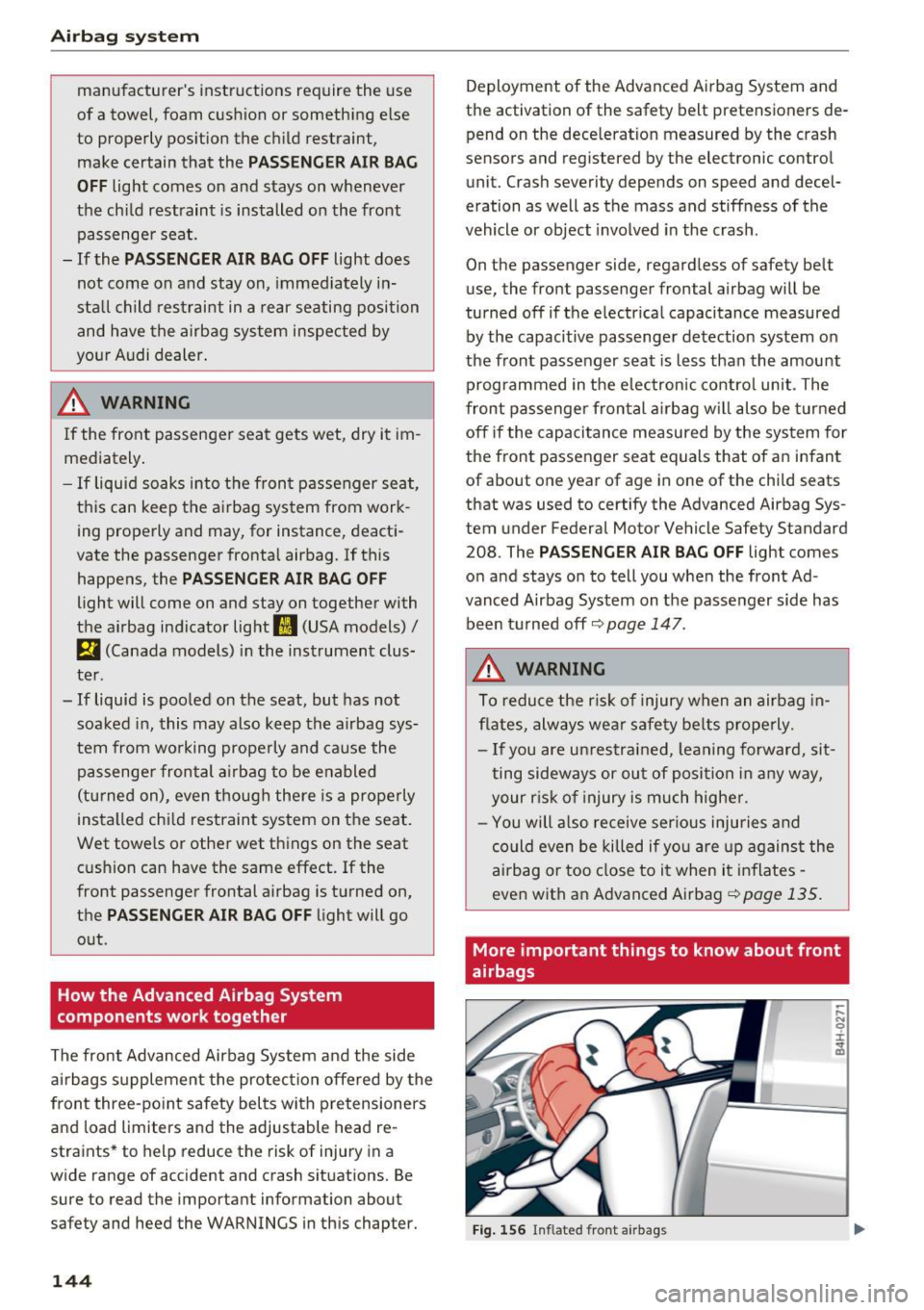
Airbag syste m
manufacturer's instructions require the use
of a towel, foam cushion or someth ing else
to properly pos ition the child restraint,
make certain that the
PAS SENGE R A IR BAG
OFF
light comes on and stays on whenever
the chi ld restraint is installed on the front
passenge r seat.
- If the
PASSEN GER AIR BAG OFF light does
not come on and stay on, immediately in
sta ll child restraint in a rear seating position
and have the airbag system inspected by
your Audi dealer.
_& WARNING
If the front passenger seat gets wet, dry it im
mediately .
- If liquid soaks into the fron t passenger sea t,
t h is can keep the a irbag system from work
ing properly and may, for instance, deacti
vate the passenger frontal airbag. If this
happens, the
PA SSENGER AIR BAG OFF
light will come on and stay on together with
the airbag indicator light
fl (USA models)/
El (Canada models) in the instrument clus
te r.
- If liquid is pooled on the seat, but has not
soaked in, this may also keep the airbag sys
tem from working properly and ca use the
passenge r frontal a irbag to be e nabled
(tu rned on), even though there is a properly
ins talled chi ld restraint system on the seat.
Wet towe ls or other wet things on the seat
cushion can have the same effect. If the
front passenger frontal airbag is turned on,
the
PAS SENGER AIR BAG OFF light will go
out.
How the Advanced Airbag System
components work together
The front Advanced Airbag System and the side
ai rbags s upplement the protection offered by the
front three-po int safety belts with pretensioners
and load limiters and the adjustable head re
stra ints* to help reduce the risk of injury in a
wide range of accident and crash situations. Be sure to read the important information about
safety and heed the WARNINGS in th is chapter.
144
Deployment of the Advanced A irbag System and
the activation of the safety belt pretensioners de
pend on the dece leration measured by the crash
sensors and registered by the electronic contro l
unit. Crash severity depends on speed and decel
e ration as well as the mass and stiffness of the
vehicle or object involved in the crash .
On the passenger side, regard less of safety belt
use, the front passenger frontal airbag will be
turned off if the e lectr ica l capacitance measured
by the capacitive passenger detection system on
the front passenger seat is less than the amount programmed in the elec tron ic cont rol unit . The
front passenger fron tal a irbag w ill also be turned
off if the capacitance measured by the system for
the front passenger seat equals that of an infant
of about one year of age in one of the child seats
that was used to certify the Advanced Airbag Sys
tem under Federal Motor Vehicle Safety Standard 208. The
PAS SENGER AIR BAG OFF light comes
on and stays on to tell you when the front Ad
vanced Airbag System on the passenger side has been tu rned off
c:> page 147 .
_& WARNING
To reduce the ris k of injury when an airbag in
flates, always we ar safe ty belts prope rly.
- If you are un restrai ned, leaning forward, sit
ting sideways or out of posi tion in any way,
your r isk o f injury is much highe r.
- You will a lso receive ser ious injuries and
co uld even be killed if yo u are up agains t the
ai rbag or too close to it when i t inflates -
even with an Advanced Airbag
c:> page 135.
More important things to know about front
airbags
Fig . 156 Inflated front a irbags
" "' 0 ± ., a,
Page 147 of 282

Safety belts are important to help keep front
seat occupants in the proper seated position so
that airbags can unfold properly and provide sup p lemental protection in a frontal collision.
The front airbags are designed to provide addi
tional protection for the chest and face of the
driver and the front seat passenger when:
- safety belts are worn prope rly,
- the seats have been positioned so that the oc -
c u pant is properly sea ted as far as possible
from the airbag,
- and for adjustable head restraints: the head re-
straints have been properly adjusted.
Because airbags inflate in the blink of an eye w ith
g reat fo rce , things you have on your lap or have
p laced on the seat cou ld become dangerous pro
jectiles , and be p ushed into you if the ai rbag in
flates.
When an a irbag deploys, fine dust is released.
This is normal and is not caused by a fire in the
ve hicl e. Thi s dust is made up mostly of a powder
used to lubricate the airbags as they deploy. It
could irritate skin.
I t is important to remember that whi le the s up
p lemental airbag sys tem is designed to reduce
the likelihood of serious injuries, other inj uries,
for example swelling , bruising and minor abra
sions, can a lso happen when airbags inflate . Air
bags do not protect the arms or the lower parts
of the body. Front airbags supplement the three
point safety belts only in some frontal collisions
i n which the ve hicle decelerat io n is high enough
to deploy the airbags .
Front airbag s will not deploy:
- if the ignit ion is switched off when a crash oc-
curs,
- in side collisions,
- in rear-end collisions,
- in rollove rs,
- when the c rash decelerat io n meas ured by the
airbag system is less than the minimum thresh-
;::: old needed for airbag deployment as registered
er: u by the electronic contro l unit. 'SI: ,....,
The front passenge r airbag also will not
deplo y:
-when the front passenger seat is not occupied,
- when the e lectrica l capaci tance measured by
the capacitive passenger detection system for
the front pass enger seat indicates that the pas
senger s ide frontal airbag must be switched off
by the electronic control un it (the
PA SSENGER
AIR BAG OFF
light c:> page 147 and how they
work comes on and stays on) .
A WARNING ,..__ -Sitting in the wrong position can increase the
r isk of ser ious injury in crashes.
- To reduce the r isk of injury when the ai rbags
inflate, the drive r and passenge rs must al
ways sit in an up right posit ion, m ust not
lean aga inst or place any part of their body
too close to the area where the airbags are located .
- Occupants who are unbelted, out of posit ion
or too close to the airbag can be serio usly
injured by an airbag as it unfolds with great
force in the blink of an eye c:> page 136.
A WARNING
A child in a rearward-facing child seat instal l ed on the front passenger seat will be seri
ously injured and can be killed if the front air
bag inflates -even with an Advanced Airbag
System .
- The inflating airbag will h it the ch ild seat or
infant carrier with great force and wi ll
smash the child seat and child against the
backrest, center armrest, doo r o r r oof.
- Always install rear-fac ing child seats on the
rear seat .
- If you must install a rea rwa rd facing child
seat on the front passenge r seat because of
except ional circumstances and the
PASSEN
GER AIR BAG OFF
l ight does not come on
a nd stay on, immed iate ly install the rear
facing child seat in a rear seating posit ion
and have the airbag system inspected by
your Audi dea ler.
145
Page 148 of 282
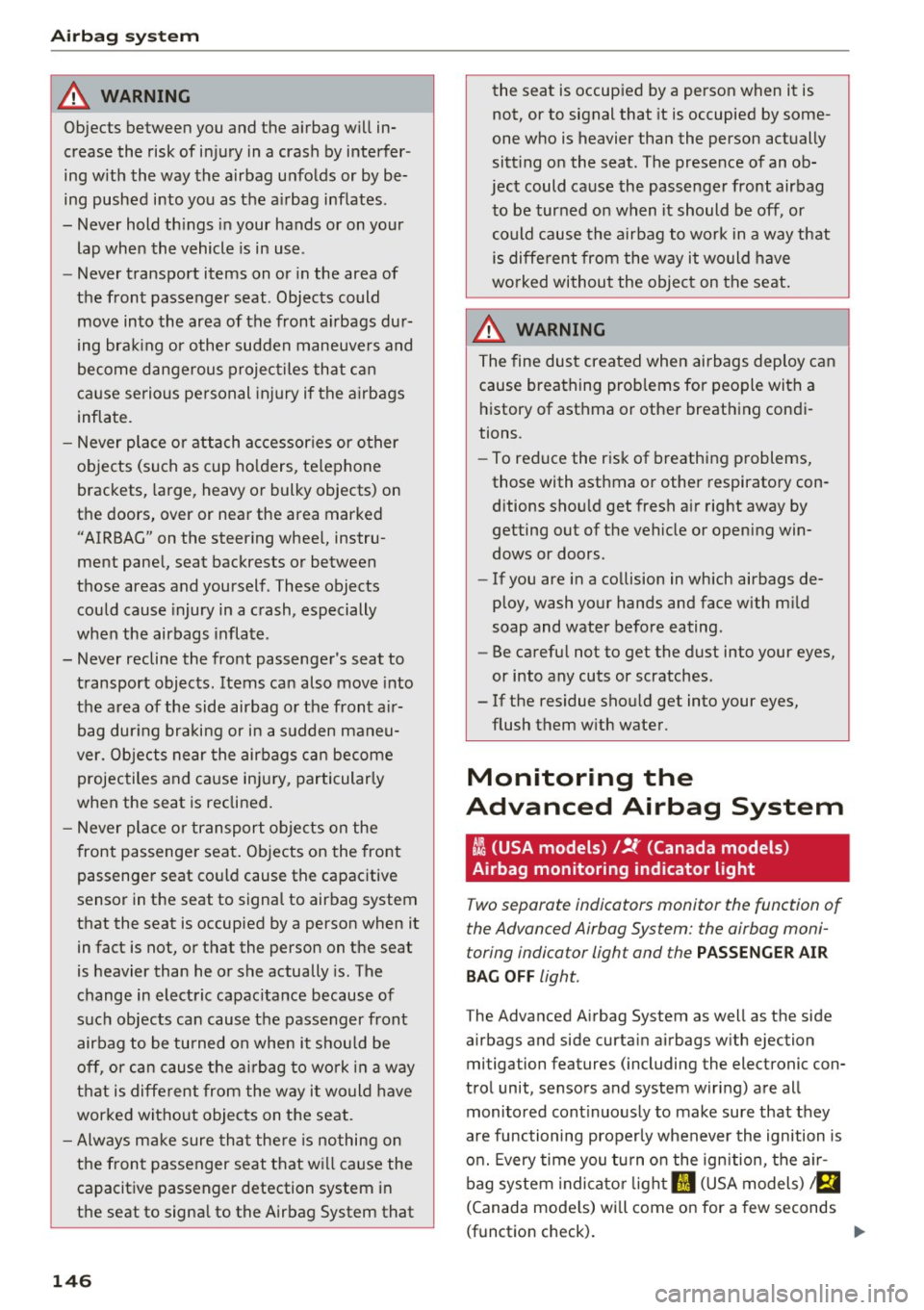
Airbag syste m
A WARNING
Objects between you and the airbag will in
cr ease the risk of inju ry in a cras h by interfer
ing w ith the way the airbag unfol ds or by be
ing pushed into you as the a irbag inflates.
- Never hold th ings in your hands or on your
lap when the vehicle is in use.
- Never transport items on or in the area of
the front passenger seat . Objects could
move into the area of the front airbags du r
ing bra king or other sudden maneuve rs and
become dangerous projectiles that can
ca use serious pe rsonal injury if the a irbags
inflate.
- Never pl ace or attach accessor ies or o ther
objects (such as cup ho lders, te lephone
brackets, large, heavy o r bulky objects) on
the doors, over or near the area marked "AIRBAG" on the steering wheel, instru
ment pane l, seat backrests or between
those areas and yourself. These objects
could cause injury in a crash, especially
when the airbags inflate.
- Never recline the front passenger's seat to transport objec ts. Items can also move into
t h e a rea of the side airbag o r the front a ir
bag during braking or in a s udden maneu
ver. Objects near the airbags can become
projectiles and cause in ju ry, particularly
when the seat is reclined.
- Never pl ace or transport o bje cts on the
front passenge r seat . Objects on the front
passenge r seat co uld cause the capac itive
sensor in the seat to signal to airbag system
that the seat is occupied by a person when it
in fact is not, or that the person on the seat
is heavier than he or she actually is. The
change in elect ric capac itance because of
s u ch objects can cause the passenger front
airbag to be turned on when it shou ld be
off, or ca n cause the a irbag to wo rk i n a way
that is diffe rent from the way it would have
wor ked witho ut objects on the seat.
- Alway s m ake sure th at the re is nothing on
t h e fron t passenger seat that w ill cause the
capacit ive passenger detection system in
the seat to signa l to the Airbag System that
146
the seat is occup ied by a person when it is
not, or to signal that it is occupied by some
one who is heavier than the person actually
sitt ing on the seat . The presence of an ob
ject could ca use the passenger front airbag
to be turned on when it should be off, or
could cause the airbag to work in a way that is diffe rent from the w ay it would have
wo rked withou t the object on the seat.
A WARNING
-
The fine dus t created when airbags deploy c an
cause breathing prob lems for peo ple with a
h istory of asthma or othe r breath ing cond i
tions.
- To reduce the r is k of breathing p roblems,
those with asthma o r other respiratory con
ditions shou ld get fresh a ir right away by
getting out of the vehicle or opening win
dows or doors .
- If you are in a co llision in which airbags de
ploy, wash yo ur hands and face with m ild
soap and water before eating.
- Be ca refu l not to get the dust into your eyes,
or into any cuts or scratches.
- If the residue sho uld get into your eyes,
flush them w ith wate r.
Monitoring the
Advanced Airbag System
t~ (USA models) !!I: (Canada models)
Airbag monitoring indicator light
Two separate indicators monitor the function of
the Advanced Airbag System: the airbag moni
toring indicator light and the
PASSENGER AIR
BAG OFF
light.
The Advanced A irbag System as well as t he side
airbags and side curta in airbags w ith ejection
mitigation features (including the electronic con
tro l unit, senso rs and system w iring) are all
monito red cont inuo usly to make sure that they
a re functioning properly whenever the ignition is
o n. Every time you tu rn o n the ign ition, the air
bag sys tem indi cato r li ght
II (USA models) a
(Canada mode ls) will come on for a few seconds
(function check). .,.
Page 149 of 282
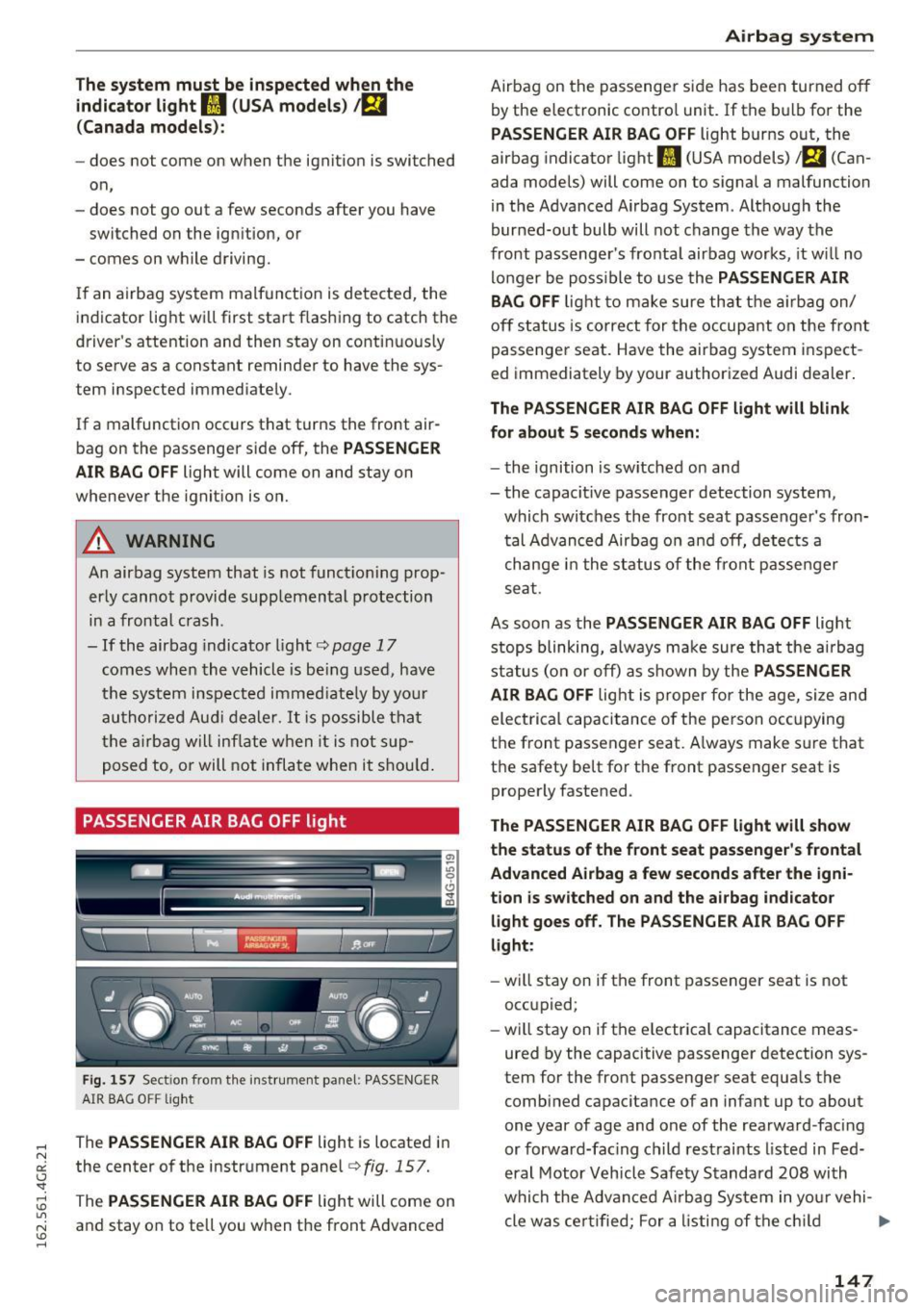
The system must be inspected when the indicato r light
II (USA models ) !E,I
( Canada models):
- does not come on when the ignitio n is switched
on,
- does not go out a few seconds after you have
switched on the ign ition, or
- comes on while driving.
I f an airbag system malf unct io n is de tected, the
indicator light wi ll first start flashing to catch the
driver's attention and then stay on co nti nuo usly
to se rve as a constant reminder to have the sys
tem i nspected immed iate ly.
If a malfunction occ urs that turns the front air
bag on the passenger si de
off, the PASSENGER
AIR BAG OFF
light will come on and stay on
whenever the ignit io n is on.
A WARNING
An airbag system that is not funct io ning prop
erly cannot provide supp lemen tal p rotec tion
in a front al c rash .
- If the air bag indicato r ligh t
c:;, page 17
come s whe n the vehicle is be ing use d, have
th e sys te m in sp ecte d im med iate ly by yo ur
au thoriz ed Au di deale r.
It is po ss ible that
th e air bag wi ll inf late w hen it is not sup
posed to, or will not i nfla te w hen it s hou ld .
PASSENGER AIR BAG OFF light
Fi g. 157 Sect ion from t he inst rum ent pa ne l: PASSENGER
AIR BAG OFF lig ht
The PASSENGER AIR BAG OFF light is located i n
the center o f the instr ument panel
c:;, fig . 157.
The PASSENGER AIR BAG OFF light will come on
and stay on to te ll you when the front Advanced
Airbag system
Airba g on the pas senge r si de has been turned o ff
by the electronic contro l unit. If t he bulb for the
PASSENGER AIR BAG OFF light burns out, the
airbag indicato r light
II (US A models) a (Can
ada models) will come on to signal a malfunction
i n the Advanced Airbag System . Alt hough the
bur ned-out bulb will not change the way the
front passenge r's fronta l airbag work s, it w ill no
lo nger be poss ible to use the
PASSENGER AIR
BAG OFF
lig ht to ma ke sure th at th e air bag on/
of f st atus is corre ct for the occup ant on the fron t
p assenge r seat. Have the air bag system i nsp ect
ed immediately by your author ized Audi dealer.
The PASSENGER AIR BAG OFF light will blink
for about 5 seconds when:
- th e ignition is switche d on an d
- the capacit ive passenger detection system,
which switc hes the front sea t passe nger' s fron
t al A dva nced Airbag o n an d off, de tec ts a
ch ange in the st atu s of the fr ont passe nger
se at.
As soon as the
PASSENGER AIR BAG OFF light
s top s blinking , always m ake sure th at the air bag
s tatu s (o n or off) as shown by the
PASSENGER
AIR BAG OFF
lig ht is pr oper for the age, siz e and
ele ctrica l capaci tance o f the pe rso n occu pying
t h e front passenger seat. A lwa ys make s ure t hat
t h e safety be lt fo r th e front passen ger seat is
prope rly faste ned .
The PASSENGER AIR BAG OFF light will show
the status of the front seat passenger 's frontal
Advanced Airbag a few seconds after the igni·
tion is switched on and the airbag indicator light goes off. The PASSENGER AIR BAG OFF
light:
- will stay on if t he front passenger seat is not
occ upied;
- wi ll stay on if t he e lectrica l capacitance meas
ured by the capacitive passenger detection sys
tem for the front passenger seat equa ls the
combined ca pac ita nce of an infa nt up to ab out
one year of age and one of the rearwa rd -facing
or fo rwar d-fac ing ch ild rest raints l isted in Fe d
e ral Motor V ehicl e Safe ty S tandard 20 8 wi th
whi ch th e A dvanc ed Airbag Sys tem i n yo ur vehi-
cle w as ce rtifie d; For a listin g of t he c hild .,.
147
Page 150 of 282

Airbag system
restraints that were used to certify your vehi
cle's compliance with the U.S . Safety Standard
~ page 161.
-will go out if the front passenger seat is occu
pied by an adult as registered by the capacitive
passenger detection system.
- The
PASSENGER AIR BAG OFF light must come
on and stay on if the ignition is on and ...
- a car bed has been installed on the front pas
senger seat, or
- a rearward -facing child restraint has been in
sta lled on the front passenger seat, or
- a fo rwa rd-facing child restraint has been instal
led on the front passenger seat,
- and if the electrica l capacitance registered on
the front passenger seat is equa l to or less than
the comb ined capacitance of a typica l 1 year
o ld infant and one of the rearward-facing or
forward-facing child restraints listed in Federal
Motor Vehicle Safety Standard 208 with which
the Advanced Airbag System in your vehicle was
certified.
If the front passenger seat is not occupied, the
front airbag w ill not deploy, and the
PASSENGER
AIR BAG OFF light will stay on. Never install a
rearward-fac ing ch ild restraint on the front pas
senger seat, the safest place for a child in any
kind of child restraint is at one of the seating po
sitions on the rear seat~
page 136, Child re
straints on the front seat -some important
things to know
and ¢ page 159, Child safety .
If the PASSENGER AIR BAG light comes
on ...
If the PASSENGER AIR BAG OFF light comes on
when one of the conditions listed above is met,
be sure to check the light regularly to make cer
tain that the
PASSENGER AIR BAG OFF light
stays on continuous ly whenever the ign ition is
on. If the
PASSENGER AIR BAG OFF light does
not appear on and does not stay on all the time,
stop as soon as it is safe to do so and
- reactivate the system by turning the ignition off for more than 4 seconds and then turning it
on again;
- remove and reinstall the child restraint. Make
sure that the child restraint is properly instal-
148
led and that the safety belt for the front pas
senger seat has been correctly routed through
the child restraint as described in the child re
straint manufacturer's instructions;
- make sure that the convertible locking retrac
tor on the safety belt for the front passenger
seat has been activated and that the safety belt
has been pulled tight.
- make sure that no electrical device (such as a laptop, CD player, electron ic games device,
power inverter or seat heater for child seats) is
placed or used on the front passenger seat if
the device is connected to the 12-volt socket or
the cigarette lighter socket;
- make sure that no seat heater has been retro
fitted or otherw ise added to the front passen
ger seat;
- make sure that noth ing can interfere with the
safety belt buckles and that they are not ob
structed;
- make sure that there are no wet objects (such
as a wet towe l) and no water or other liquids on
the front passenger seat cushion.
If the PASSENGER AIR BAG light still does
not come on ...
If the PASSENGER AIR BAG OFF light still does
not come on and does not stay on continuously
(when the ignition is switched on),
- take the child restra int off the front passenger
seat and insta ll it p roperly at one of the rear
seat positions. Have the airbag system inspect
ed by yo ur Audi dealer immediate ly.
- move the child to a rear seat position and make
sure that the child is properly restrained in a
child restraint that is appropriate for its size
and age .
The PASSENGER AIR BAG light should NOT
come on .. .
The PASSENGER AIR BAG OFF light should NOT
come on when the ignition is on and an adu lt is
sitting in a proper seating position on the front
passenger seat. If the
PASSENGER AIR BAG OFF
light comes on and stays on or flashes for about
5 seconds while dr iv ing, under these c ircumstan-
ces, make sure that: ..,.